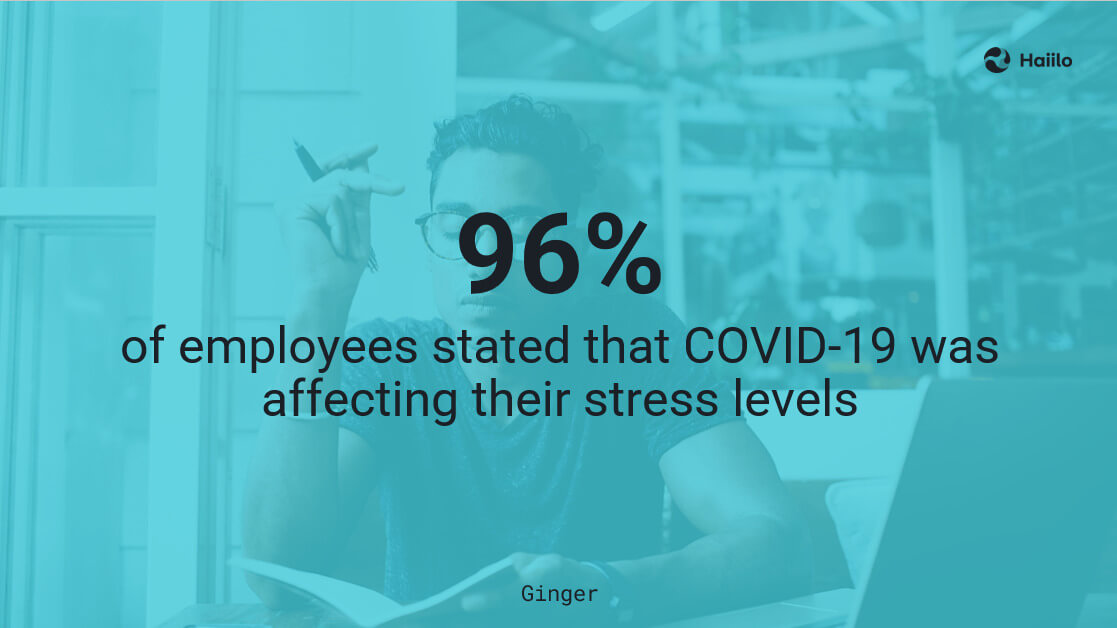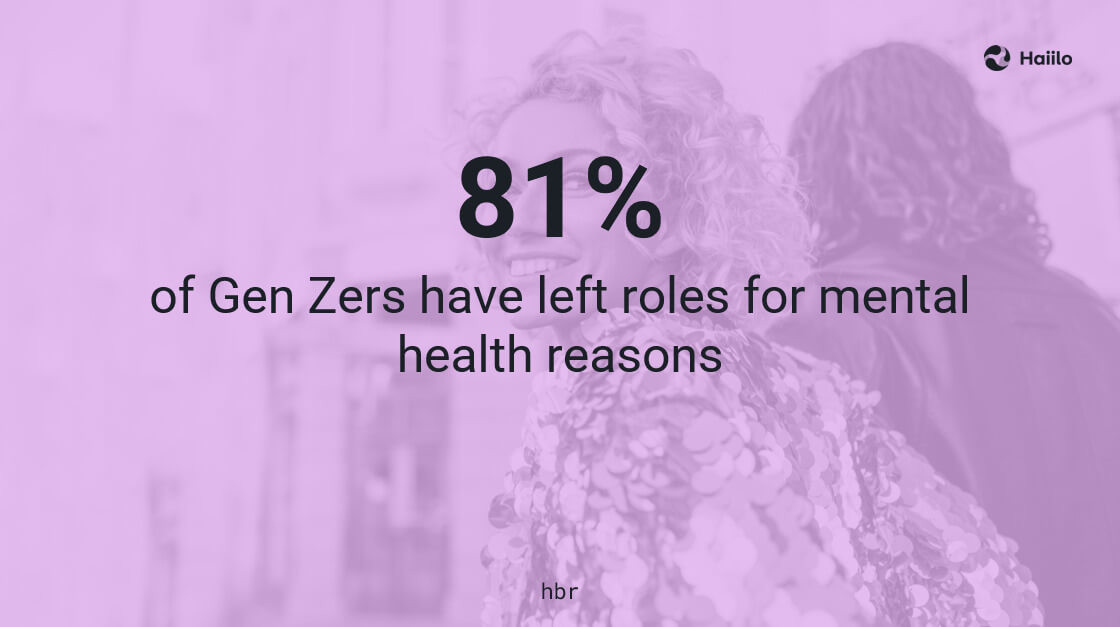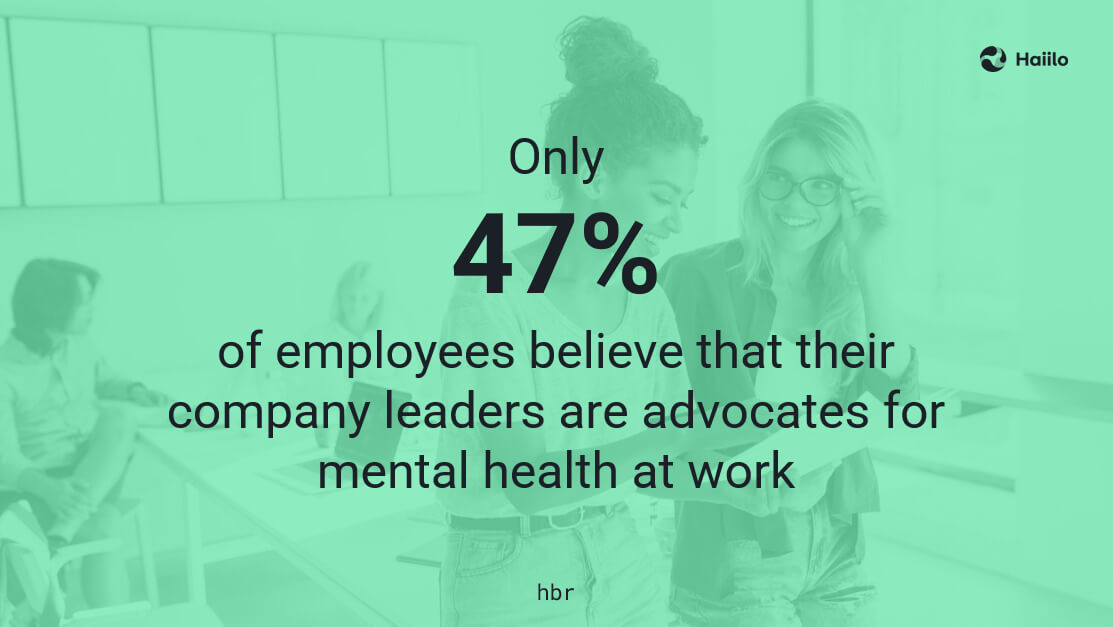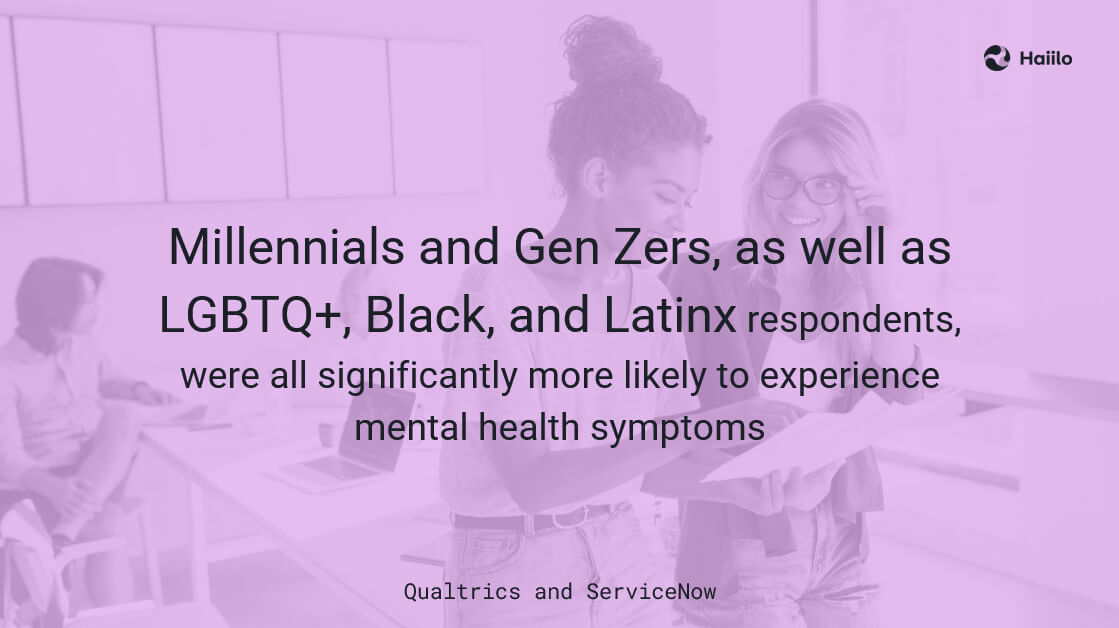Mental health in the workplace is a growing concern for many employers across the globe. As poor mental health in the workplace has a negative impact on employee morale, well-being, engagement, and productivity at work, organizations are tasked with finding the best ways to improve the mental health of their people.
In this blog, we will talk about why you should be concerned about your employees’ mental health and how to better support your workers.
The History of Mental Health In the Workplace
Less than a decade ago, mental health wasn’t on the list of top priorities for companies, and many employers never discussed it.
As the World Health Organization started investing more in mental health research, awareness of this problem has increased exponentially. According to WHO, 15% of working-age adults were estimated to have a mental disorder in 2019.
Consequently, in 2020, mental health support went from a nice-to-have to a true business imperative, especially as the problem increased in prevalence due to COVID-19. According to research by Ginger, 96% of employees stated that COVID-19 affected their stress levels, and additional research indicates that we haven’t recovered.
Between 2021 and 2023, awareness about workplace factors impacting employees’ health began to skyrocket, and a 2024 study by Aflac determined that 57% of people employed are experiencing some level of burnout.

Top 4 Reasons to Worry About Your Employees’ Mental Health
“Workplaces that promote mental health and support people with mental disorders are more likely to reduce absenteeism, increase productivity and benefit from associated economic gains.”
– World Health Organization
Hence, it is no surprise that more and more organizations are investing in various mental health initiatives and implementing employee well-being programs.
1. Employee engagement
Some research indicates that many employers today are facing record-low employee engagement levels. Employees who are dealing with mental health challenges are often unable to motivate themselves to do their jobs, resulting in low engagement.
This is particularly true within companies that are indifferent to those challenges.
📗 Also check out our ultimate employee engagement guide and employee experience guide!
2. Employee productivity
Lower productivity is another major consequence of poor mental health in the workplace. According to research, an estimated 12 billion working days are lost every year to depression and anxiety at the cost of US$ 1 trillion per year in lost productivity.
3. Employee turnover
Workers with mental health challenges are also more likely to leave their employers. 68% of Millennials (50% in 2019) and 81% of Gen Zers (75% in 2019) have left roles for mental health reasons, both voluntarily and involuntarily, compared with 50% of respondents overall (34% in 2019).

📗 Learn about 8 ways to combat high employee turnover!
4. Employee safety
Oftentimes, poor mental health makes it harder for employees to follow their organization’s safety protocols, resulting in more work-related injuries.
Depression interferes with a person’s ability to complete physical job tasks about 20% of the time and reduces cognitive performance about 35% of the time.
How to Help Employees Improve Their Mental Health
Every company is different. While some negative mental health factors may be more dominant in some companies than others, there are some best practices every company should follow to improve the mental health of their employees.
1. Raise awareness and create an open workplace culture
HR and internal communications professionals must add mental health to their list of top priorities. First, they need to raise awareness about this topic, create a positive workplace culture, and encourage employees to feel comfortable talking about it openly.
As reported in a previously mentioned research, the “resource” most desired by respondents (31%) was a more open culture around mental health.
Furthermore, only 49% of respondents described their experience of talking about mental health at work as positive or reported that they received a positive or supportive response.
💡 Extra tip: To start, you can simply create a bi-weekly or monthly internal employee newsletter to educate employees or invite them to openly or anonymously talk about their challenges.
2. Educate your leaders
The role of leadership in improving mental health in the workplace is critical. Managers have the biggest power to create a healthy work atmosphere around their teams. They are the ones who can impact workplace relationships.
Even though transformational leaders are getting better at understanding the factors behind poor mental health, there is still room for improvement.
Only 47% of employees believe that their company leaders are advocates for mental health at work, and 47% believe that their manager is equipped to support them if they have a mental health condition or symptom.

Leaders should serve as allies by sharing their own personal experiences to foster an environment of transparency and openness.
💡 Extra tip: implement a monthly mental health podcast and invite your leaders to participate in the panel. Make it as open as possible and allow employees to join the conversation.
📗 Check out these 18 leadership communication trends!
3. Offer flexibility
Flexible work arrangements have proved to have a positive impact on employees’ mental health.
One research about the COVID-19 pandemic showed that some companies’ return-to-office plans were negatively impacting employees’ mental health. The top two reasons given were the policies around in-person versus remote work (41%) and the lack of work-life balance or flexibility based on the policy (37%).
However, to offer flexibility, trust must be present. Employers need to know how to promote autonomy, establish norms and boundaries, and define some synchronous and asynchronous communication rules.
💡 Extra tip: Consider shortening Friday working hours, giving a day off for your employees’ birthdays, or on the World’s Mental Health Day.
4. Encourage positive workplace relationships
With the emergence of remote work, people are more prone to feel lonely, and they are missing a sense of belongingness with their peers and employers.
To build a culture of connection, employers need to talk about the characteristics of such a culture and enable employees to build relationships.
Employers should provide apps and technologies to enable organization-wide opportunities for employees to connect and teams to collaborate successfully.
💡 Extra tip: If you are a fully remote company, there is a big chance that your employees never get a chance to meet each other. So consider implementing random one-on-one meetings for people from different departments and suggest a few chat topics to help them break the ice.
You can also create groups or channels based where people with similar interests can chat about work and non-work-related topics.
5. Implement an employee well-being program
Previously mentioned research showed that the workers who felt supported with their mental health overall were 26% less likely to report at least one symptom of a mental health condition.
Furthermore, nearly 60% of adults with mental health conditions didn’t receive mental health services.
To show your employees that their mental health is important to them, consider implementing a formal employee well-being program. Contrary to popular belief, there are many low-cost employee wellness program ideas. However, they will require time and dedication from your side when it comes to setting up the program and tracking its success.
💡 Extra tip: To encourage your employees to participate in the program, add some gamification to it by recognizing and rewarding those who are more engaged.
6. Measure the pulse of your employees
Employee share of voice should be one of the core company values of every organization.
Encourage your employees to share their feedback, raise concerns, and ask questions. One of the best ways to start is by implementing regular employee surveys.
After collecting responses, it is critical that you act on the results and create a strategy for improvement. Since mental health in the workplace has a negative impact on employee engagement, it is always a good idea to start asking a few simple employee engagement questions.
💡 Extra tip: Make surveys mobile-friendly, particularly if your workforce is multigenerational or consists of a lot of frontline workers. Mobile-friendly survey technology can go a long way in increasing the overall response rate.
7. Follow the DEI (diversity, equity, and inclusion) best practices
Discrimination and inequality based on factors such as race, sex, gender identity, sexual orientation, disability, social origin, migrant status, religion, or age are some of the leading factors of poor mental health in the workplace.
According to research, Millennials and Gen Zers, as well as LGBTQIA+, Black, and Latinx respondents, were all significantly more likely to experience mental health symptoms.

💡 Extra tip: Make sure that you eliminate bias in your talent acquisition and recruitment efforts. Consider implementing DEI training for your HR team (mainly recruiters) and hiring managers.
Risks to Mental Health In the Workplace (according to WHO)
To help employers prevent mental health challenges in their workplaces, WHO has come up with a list of common mental health risk factors:
- Employees not using their skills to the extent they wish or not being skilled to do their jobs successfully
- Excessive workload, long working hours, and inflexible working hours
- Lack of control and autonomy in their own work
- Limited opportunities for advancement and career growth, under and over-promotion
- Job insecurity
- Unsafe working environment
- Violence, harassment, or bullying
- Unhealthy organizational culture
- Unclear job role, goals, and objectives
- Limited support from colleagues and managers
- Discrimination and exclusion
If you are looking for a modern employee experience platform that can help you raise awareness about mental health in the workplace, connect your workforce, and actively measure their pulse, schedule a Haiilo demo today!










